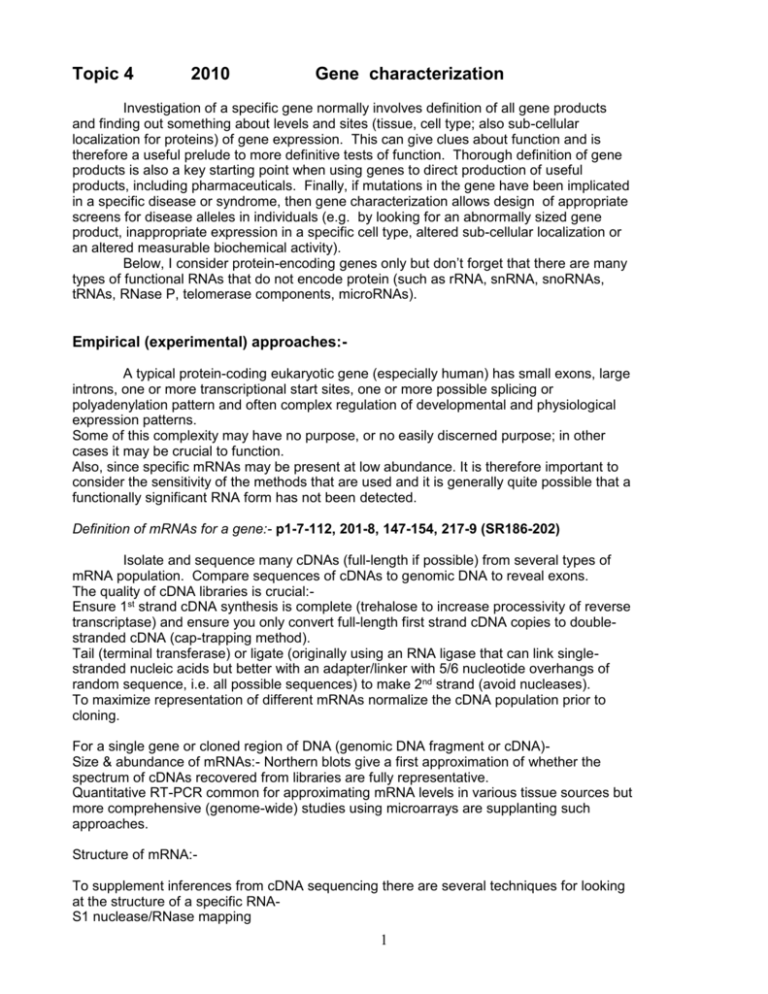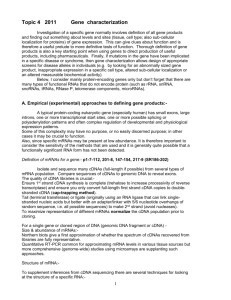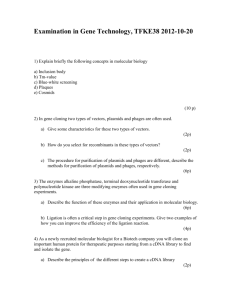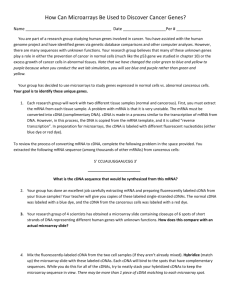Topic 4 2010 Gene characterization
advertisement

Topic 4 2010 Gene characterization Investigation of a specific gene normally involves definition of all gene products and finding out something about levels and sites (tissue, cell type; also sub-cellular localization for proteins) of gene expression. This can give clues about function and is therefore a useful prelude to more definitive tests of function. Thorough definition of gene products is also a key starting point when using genes to direct production of useful products, including pharmaceuticals. Finally, if mutations in the gene have been implicated in a specific disease or syndrome, then gene characterization allows design of appropriate screens for disease alleles in individuals (e.g. by looking for an abnormally sized gene product, inappropriate expression in a specific cell type, altered sub-cellular localization or an altered measurable biochemical activity). Below, I consider protein-encoding genes only but don’t forget that there are many types of functional RNAs that do not encode protein (such as rRNA, snRNA, snoRNAs, tRNAs, RNase P, telomerase components, microRNAs). Empirical (experimental) approaches:A typical protein-coding eukaryotic gene (especially human) has small exons, large introns, one or more transcriptional start sites, one or more possible splicing or polyadenylation pattern and often complex regulation of developmental and physiological expression patterns. Some of this complexity may have no purpose, or no easily discerned purpose; in other cases it may be crucial to function. Also, since specific mRNAs may be present at low abundance. It is therefore important to consider the sensitivity of the methods that are used and it is generally quite possible that a functionally significant RNA form has not been detected. Definition of mRNAs for a gene:- p1-7-112, 201-8, 147-154, 217-9 (SR186-202) Isolate and sequence many cDNAs (full-length if possible) from several types of mRNA population. Compare sequences of cDNAs to genomic DNA to reveal exons. The quality of cDNA libraries is crucial:Ensure 1st strand cDNA synthesis is complete (trehalose to increase processivity of reverse transcriptase) and ensure you only convert full-length first strand cDNA copies to doublestranded cDNA (cap-trapping method). Tail (terminal transferase) or ligate (originally using an RNA ligase that can link singlestranded nucleic acids but better with an adapter/linker with 5/6 nucleotide overhangs of random sequence, i.e. all possible sequences) to make 2nd strand (avoid nucleases). To maximize representation of different mRNAs normalize the cDNA population prior to cloning. For a single gene or cloned region of DNA (genomic DNA fragment or cDNA)Size & abundance of mRNAs:- Northern blots give a first approximation of whether the spectrum of cDNAs recovered from libraries are fully representative. Quantitative RT-PCR common for approximating mRNA levels in various tissue sources but more comprehensive (genome-wide) studies using microarrays are supplanting such approaches. Structure of mRNA:To supplement inferences from cDNA sequencing there are several techniques for looking at the structure of a specific RNAS1 nuclease/RNase mapping 1 Primer extension 5’ and 3’ RACE, rapid amplification of cDNA ends (primer extension + PCR) Ideally cDNA clones are perfect copies of each type of mRNA. As genomic projects approach this goal the methods above are used less frequently. However, representation of 5’ ends of mRNAs remains a common problem for cDNA libraries and transcription start sites are very hard to predict on the basis of genomic sequence. Hence, 5’ RACE is the most commonly applied of these techniques. Proteins:Antibodies are key reagent that allows detection of protein size and isoforms by Western blot or immune precipitation of labeled products, and assay of abundance & sub-cellular localization (by biochemical fractionation or in situ staining methods). However, antibodies vary greatly in affinity, cross-reactivity, ability to recognize protein in native or denatured forms and so it is very hard to use antibodies in quantitative studies (to compare the amounts of two different proteins) or to be sure that all detected proteins are real target gene products (antibodies may cross-react unpredictably with other proteins or may not recognize the correct protein in a particular post-translationally modified state). Prediction of gene products p167-196, 261-273 (SR 221-4; 250-2; 291-4) The cell “knows” how to “read” a genome, i.e. where to start transcription, splice, polyadenylate, initiate and terminate translation and where to modify proteins so if we knew the rules being followed, or even if we knew enough examples of this “reading” process we ought to be able to predict gene products directly from genome sequence. At present, however, this can only be done to a limited degree. mRNAs:Candidate splice junctions and polyA addition sites can be predicted from short sequence motifs but for a large gene (say 100kb or more of DNA rather than 5-10kb) there are too many choices. Transcription start sites have only very loose consensus but identification can be aided for some genes by TATA box (or similar elements) close to the transcriptional start site. Since genes can overlap and both start sites & polyadenylation sites are not easily predicted in a large sequence space it is very difficult to pin down the termini of a transcription unit. The most successful predictive criteria focus on finding protein-coding regions. Such regions are recognized by the length of a potential open reading frame, by making use of homology (loosely, sequence similarity) to other conceptual translation products and codon usage (because some codons for the same amino acid are generally used more than others in keeping with the relative abundance of different tRNAs). Protein products:Usually easy to predict a protein product once mRNA is defined because most eukaryotic mRNAs are monocistronic, initiate translation at first AUG from 5’ end (or very close), which conforms to a short consensus motif; stop codons explicit and absolute. Rare exceptions (often in viruses, protozoa..) include Non-AUG start codons Internal initiation (IREs) Partial read-through of stop codons RNA editing 2 Also note that primary translation products are often processed, including altering primary amino acid sequence because of :Signal sequence removal Processing of pro-peptides Aminopeptidase and much less commonly, Inteins (self-removing sequences) or Trans-splicing Genome annotation involves displaying combined information from experimental data and predictions. Very little of the information is thoroughly proven. Most are best guesses with links to the direct evidence on which this is based. Expression patterns of genes p313-26 (SR 175-8, 545-553):For single genes this was previously accomplished using Northern blots, RNase protection, quantitative RT-PCR on different tissue samples. Quantitation often employs real-time PCR (as in TaqMan assay). In situ hybridization Genome-wide assays of expression patterns are now possible using technologies such as DNA chips or Serial Analysis of Gene Expression (SAGE; basically sequencing concatamerized small fragments corresponding to 3’ ends of mRNAs to count the relative number of copies of each type of mRNA) DNA chips (microarrays) Thoroughness of assay depends entirely on knowledge of expressed sequences. If a gene is not known to be expressed as a specific predicted (or known) mRNA it will not be assayed. Principle is reverse of Northern blot with samples to be tested in solution rather than on solid support. On solid support are either oligonucleotides or larger fragments of cDNA. Key features:Glass support Non-porous (no wasted solution; faster hybridization & washing because of better access) Rigid (invariant position of attached nucleic acids, essential for accurate chip creation & scanning) Transparent (fluorescence detection) Microscopic arrays- allows use of small volumes & hence less labeled “probe” Small volume essential for signal detection. (a) Oligo arrays (Affymetrix) Synthesize on glass derivatized to anchor 3’ ends of nascent oligos. Protecting groups photolabile Fabricated masks allow patterned passage of light (lithography) activating pattern of oligos for addition of specific next nucleotide. Each cycle uses a different mask. For oligos of length N requires maximum of 4N masks. ($1,000 a mask) Oligos generally 20-25nt (random exact match for 20-mer only one in a million even if “probe” has a million bp) Oligos carefully chosen (minimize similarity to highly expressed RNAs, normalize base-composition if possible, unique sequence, avoid secondary structure). These parameters used for all oligos, hence making it likely that all genes will hybridize with similar efficiencies. Oligos available for hybridization (best if spacer used) High density (5 m spots [200,000 mol;ecules], up to 4 million per slide) 3 Reproducible synthesis from chip to chip (hence can be used to compare many samples on separate chips) Only information (no nucleic acids) required to make a chip Essential controls:Multiple oligo sequences for each mRNA (~20) for availability, reproducibility Mis-match (MM) pair for each (PM) oligo (to test specificity); subtract MM from PM & ignore if MM signal is high Limitations:Masks expensive (Nimblegene uses mirrors instead of masks; arrays are less dense [still can make 2 million on a large slide] but much cheaper & oligos can be up to 60nt as synthesis is more efficient) Hybridization conditions must be precise and cannot be optimal for all oligos (signal/noise) Oligo synthesis imperfect (worse than standard) so that long oligos cannot be used (about 80% correct for 25-mer) PNA has greater duplex stability (1.5C per bp), better specificity & lower salt requirement (no negatively charged backbone) (b) cDNA spotting (Synteni, individual labs….) Derive cDNAs from information on dbEST or Unigene but must also make DNA by PCR (generally from pure starting material- EST clones). Robotic spotting of 0.5-3kb fragments to poly-lysine or aminosilane coated glass slides. Drying etc. to fix & heat to denature. Mechanical spotting or ink-jet delivery. Can make many arrays from a set of cDNAs Up to 40,000 spots (of 100m) per slide Hybridization conditions can be very stringent & probes are long so all mRNAs should be accessible for hybridization Essential controls: Duplicate spots for spotting variability; also comparison of 2 samples on same array because array to array reproducibility is limited. Limitations:How does cDNA sit on glass?- limited availability Size of probe library Making labeled cDNA (or cRNA) probe Simplest is oligodT primed reverse transcriptase with fluorescent nucleotides (Cye3-dUTP and Cye5-dUTP for two different mRNA samples to be compared). If less than about 10-50 micrograms total RNA available some form of amplification required. Can use PCR on cDNA (add one primer by ligation of linker) or include T7 RNA pol promoter 5’ of oligodT and use dscDNA as template for making cRNA in vitro. Biotinylated nucleotides can be used & detected with streptavidin that has multiple fluorescent groups (to amplify). Detection- laser induced fluorescence measured by confocal microscope Data analysis- sophisticated grouping techniques, especially if arrays have been assayed under very many different conditions. 4








